NCERT Solutions for Class 8 Science Chapter 17 Stars and The Solar System
NCERT Solutions Class 8 Science Chapter 17 – Access and Download Free PDF
NCERT Solutions for Class 8 Science Chapter 17 Stars and The Solar System: Solution for solar system stars are part of NCERT Solutions for class 8. You know, that how beautiful our universe is, even it is more beautiful than our imagination and that’s why it is exciting as well as interesting to read about the solar system. In this chapter along with CBSE NCERT solutions for Class 8 Science chapter 17 Stars and The Solar System, you are going to know about all the things related to our solar system like orbit, Orion, phases of the moon, planets, pole star, etc.
By going through this chapter as well as solutions of NCERT for Class 8 Science chapter 17 Stars and The Solar System, you will get to know that the pole star appears to be stationary from the Earth because it is situated close to the direction of the axis of rotation of the Earth and constellations are groups of stars that appear to form recognizable shapes. To strengthen the concepts of stars and solar system class 8 chapter, first read the chapter carefully and solve every problem of NCERT on your own. If you find the difficulties while answering these questions, you can take the help of CBSE NCERT solutions for Class 8 Science chapter 17 Stars and The Solar System. You can also Check NCERT Solutions from Classes 6 to 12 to learn any concept of science.
**As per the CBSE Syllabus for the academic year 2023-24, this chapter has been removed.
Free download stars and the solar system class 8 solutions PDF for CBSE exam
NCERT Solutions for Class 8 Science Chapter 17 Stars and the Solar System
NCERT Solutions for Class 8 Science Chapter 17 Stars and The Solar System: Solved Exercise Questions
Q1. Which of the following is NOT a member of the solar system?
(a) An asteroid
(b) A satellite
(c) A constellation
(d) A Comet
Answer:
(c) A constellation is NOT a member of the solar system.
Q 2. Which of the following is NOT a planet of the sun?
(a) Sirius
(b) Mercury
(c) Saturn
(d) Earth
Answer:
(a) Sirius , is not a planet of the sun.
Answer:
Phases of the moon occur because of
( a ) we can see only that part of the moon which reflects light towards us.
Q 4. Fill in the blanks.
( a ) The planet which is farthest from the Sun is ____________ .
( b ) The planet which appears reddish in colour is ____________ .
( c ) A group of stars that appear to form a pattern in the sky is known as a ____________ .
( d ) A celestial body that revolves around a planet is known as __________.
( e ) Shooting stars are actually not ____________.
( f ) Asteroids are found between the orbits of _________ and _________ .
Answer:
( a ) The planet which is farthest from the Sun is neptune .
( b ) The planet which appears reddish in colour is Mars .
( c ) A group of stars that appear to form a pattern in the sky is known as a constellation .
( d ) A celestial body that revolves around a planet is known as satelite .
( e ) Shooting stars are actually not meteors .
( f ) Asteroids are found between the orbits of and Mars and Jupiter .
Answer:
(a) False , Pole star is not a member it is so far away from the solar system.
(b) True , Mercury is the smallest of all planets present in the solar system.
(c) False , Neptune is the farthest planet in the solar system.
(d) True , INSAT is an Indian artificial satelites.
(e) False , there are eight planets in the solar system (Mercury, Venus, Earth, Mars, Jupiter, Saturn, Uranus, Neptune).
(f) False , constellation Orion can be seen with naked eyes.
Q 6. Match items in column A with one or more items in column B .
A B
( i ) Inner planets ( a ) Saturn
( ii ) Outer planets (b) Pole star
( iii ) Constellation ( c ) Great Bear
( iv ) Satellite of the Earth ( d ) Moon
( e ) Earth
( f ) Orion
( g ) Mars
Answer:
Matched items A with B are:
| A | Matched with B |
| (i) Inner planets | (e) Earth, (g) Mars |
| (ii) Outer planets | (a) Saturn |
| (iii) Constellation | (c) Great Bear, (f) Orion |
| (iv) Satelite of the Earth | (d) Moon |
Q 7 . In which part of the sky can you find Venus if it is visible as an evening star?
Answer:
It appears in the western sky if it is visible as an evening star.
Q 8. Name the largest planet of the solar system.
Answer:
Jupiter is the largest planet of the solar system.
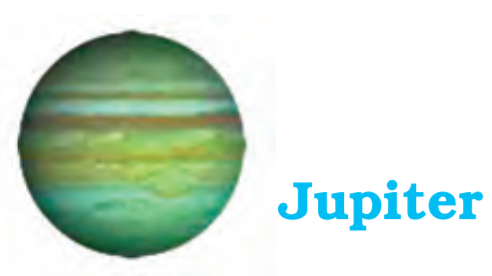
Q 9. What is a constellation? Name any two constellations.
Answer:
The stars forming a group that has a recognisable shape is called a constellation .
Two of the most famous constellations which you can see are:
(i) Ursa Major (Great Bear or the Saptarshi)
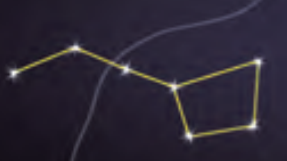
(ii) Orion
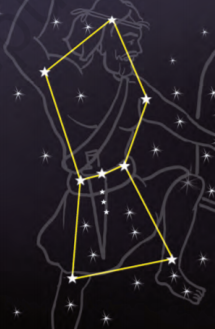
Q10 ( a ). Draw sketches to show the relative positions of prominent stars in
Ursa Major
Answer:
(a) Ursa Major, One of the most famous constellations which you can see during summer time in the early part of the night.
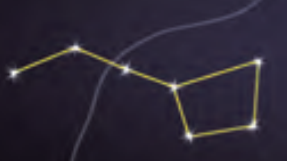
Q 10(b). Draw sketches to show the relative positions of prominent stars in
Orion
Answer:
(b) Orion, is another well-known constellation that can be seen during winter in the late evenings.
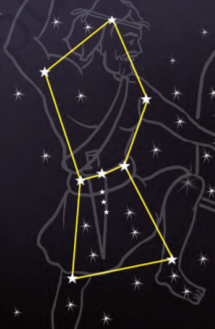
Q 11 . Name two objects other than planets which are members of the solar system.
Answer:
Asteroids and Meteors are also members of the solar system.
Q 12 . Explain how you can locate the Pole Star with the help of Ursa Major.
Answer:
We can locate the Pole Star with the help of Ursa Major by the following steps:
(i) Perform activity on a clear moonless night during summer at about 9.00 pm.
(ii) Look towards the northern part of the sky and identify Ursa Major .
(iii) Look at the two stars at the end of Ursa Major.
(iv) Imagine a straight line passing through these stars as shown in figure.
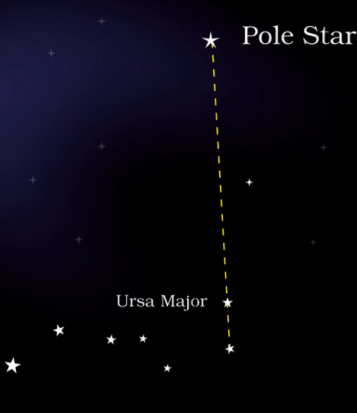
(v) Extend this imaginary line towards the north direction. This line will lead to a star which is not too bright. This is the Pole star
Q 13 . Do all the stars in the sky move? Explain.
Answer:
No , The earth rotates from west to east due to which all stars appear to move from east to west (except pole star, which lies on the axis of rotation of the earth does not seems to move).
Answer:
Some stars are at such large distances away that the lsrge distances are expressed in another unit known as light year.
So, one light year is equal to distance travelled by the light in one year i.e., (we know the speed of light is about 300,000 km per second) thus,
$1 Light year = 365\times 24\times 60\times 60\times 300,000km$
$= 9,460,800,000,000km$
So, if one light year is equal to 9,460,800,000 metres then,
Eigth light years is equal to $8\times 9,460,800,000,000km$
i.e., $75,686,400,000,000km$ .
So, it means that the star is 75,686,400,000,000 kilometres (8 light years) away from the earth which is much large distance.
Answer:
Given that the radius of Jupiter is 11 times the radius of the earth.
So, let us assume that
the radius of Earth is ' r ' then the radius of Jupiter will be ' 11r '.
So, as we know that the Volume of a sphere having radius 'x' is equal to $\frac{4}{3}\times \pi \times x^{3}$
Then, the Volume of the earth would be
$V_{earth}$ = $\frac{4}{3}\times \pi \times r^{3}$
and Volume of Jupiter will be
$V_{jupiter}$ = $\frac{4}{3}\times \pi \times (11r)^{3}$
= $(1,331)\times \frac{4}{3}\times \pi \times r^{3}$ .
So, the ratio of volumes is
$\frac{V_{jupiter}}{V_{earth}} = 1,331$ .
Hence we can conclude that 1,331 Earths can be accommodated in the planet Jupiter.

Answer:
The corrected sketch is as follows below:

Subject matter experts from Careers360 have meticulously crafted a comprehensive class 8 science chapter 17 question answer, which focuses on the topic of Stars and Solar System. The solution includes a total of sixteen questions, comprising various types such as MCQs, fill-in-the-blanks, matching, and true/false questions. The experts have presented the answers in a lucid and easy-to-understand language, making it accessible for students of all levels. In addition, the solution is available in a PDF format, which allows students to access it conveniently and use it as per their comfort.
Furthermore, the stars and solar system class 8 pdf format also allows students to download and save the solution on their devices, making it easily accessible even when offline. The experts have also provided relevant diagrams and illustrations to aid in better comprehension of the concepts covered in the chapter. Students can use this solution of pole star is a member of the solar systemas a valuable resource to enhance their understanding of the topic and improve their overall performance in the subject.
Here is the Boojho's question:
Q. Why does the moon change its shape every day?
Ans. As you have studied that moon does not produce its own light, whereas the Sun and other stars do. We see the moon because the sunlight falling on it gets reflected towards us. We, therefore, see only that part of the moon, from which the light of the Sun is reflected towards us.
After going through NCERT of Class 8 Science chapter 17 Stars and The Solar System, completely (line by line), it will become clear in your mind that why this chapter is important to study. And easily you can answer that in which part of the sky can you find Venus if it is visible as an evening star? How you can locate the Pole Star with the help of Ursa Major? And if not, then, NCERT solutions for Class 8 Science chapter 17 Stars and The Solar System will help you out in a better way.
So, try to attempt all NCERT questions of Class 8 Science chapter 17 Stars and The Solar System. In case, if you have any query, refer to below mentioned NCERT solutions for Class 8 Science chapter 17 Stars and The Solar System as it will help you to understand all the answers and score more marks in the exam.
NCERT Solutions for Class 8 Science: Chapter-Wise
Apart from stars and the solar system class 8 ncert solutions, complete chapterwise exercise solution are listed below:
| Chapter-1 | Crop Production And Management |
| Chapter-2 | Microorganisms: Friend And Foe |
| Chapter-3 | Synthetic Fibres And Plastics |
| Chapter-4 | Materials: Metals And Non-Metals |
| Chapter-5 | Coal and Petroleum |
| Chapter-6 | Combustion and Flame |
| Chapter-7 | Conservation of Plants and Animals |
| Chapter-8 | Cell Structure and Functions |
| Chapter-9 | Reproduction in Animals |
| Chapter-10 | Reaching the Age of Adolescence |
| Chapter-11 | Force and Pressure |
| Chapter-12 | Friction |
| Chapter-13 | Sound |
| Chapter-14 | Chemical Effects of Electric Current |
| Chapter-15 | Some Natural Phenomena |
| Chapter-16 | Light |
| Chapter-17 | Stars and The Solar System |
| Chapter-18 | Pollution of Air and Water |
Stars and the Solar System Class 8 NCERT Solutions: Important Points and Diagrams
The Universe: The Universe is the entirety of space, time, matter, and energy. It includes all galaxies, stars, planets, and even the empty space between them. The Universe is vast and is still largely unexplored. Its exact size is indeed unknown, and it may well be infinite.
Observable Universe: This is the portion of the Universe that can be observed from our vantage point on Earth. It's like the visible horizon in a vast landscape. The Observable Universe is finite because it has a limit based on the age of the Universe (about 13.8 billion years) and the speed at which light travels. Objects beyond this limit are so far away that their light hasn't had enough time to reach us yet. This is an essential concept in cosmology.
Celestial Objects: Celestial objects are natural objects in space that include stars, planets, moons, asteroids, comets, galaxies, and more. These objects are the building blocks of the Universe and have been studied for centuries to understand the cosmos better.
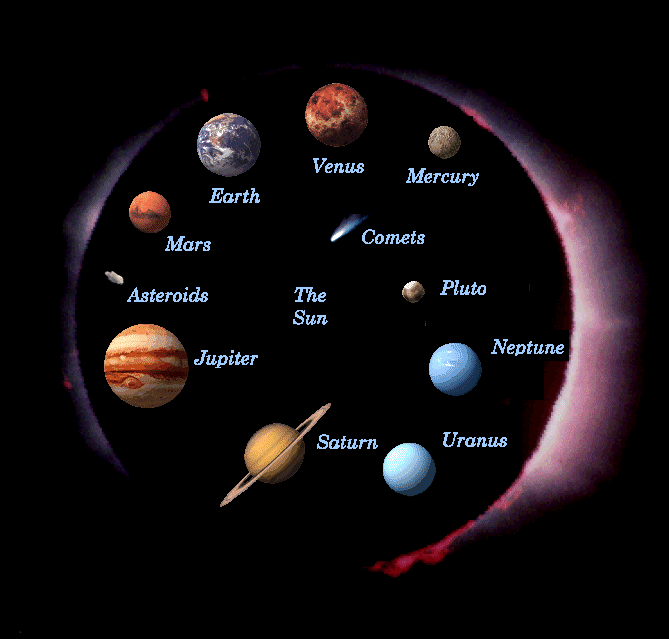
The Phases of the Moon
Moon phases repeat every 29 days, and there are eight major moon phases.
A "Full Moon Day" is when we can see the entire moon in the sky, as sunlight fully illuminates it.
As the moon revolves and changes position, the illuminated part starts to decrease, making the moon appear thinner.
On the 15th day after a Full Moon, the moon becomes completely invisible, known as a "New Moon Day."
The day after the New Moon is when the "Crescent Moon" first appears in the sky.
From this point, the moon gradually grows larger until it reaches its full shape on the 15th day, known as the "Full Moon Day."
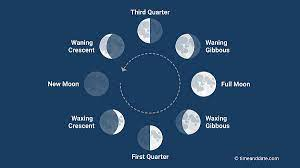
Stars
Stars are enormous balls of hot, glowing gases primarily composed of hydrogen and helium.
The energy produced by nuclear fusion in a star's core is what makes them shine.
Stars come in various sizes, colors, and temperatures, leading to a diverse range of appearances in the night sky.
Astronomers use the brightness and color of stars to classify them into different spectral types.
The life cycle of a star depends on its mass, with smaller stars having longer lifespans compared to massive ones.
Stars play a crucial role in the formation of galaxies and the universe's evolution.
Light Year
Light Year: The distance light travels in one year.
Speed of Light: 3*108 meters per second.
1 Light Year: Equal to 9.46*1012 km
Sun's Distance: 8 light minutes from Earth.
Alpha Centauri Distance: 4.3 light years away.
Stars and The Solar System Class 8 Science Chapter 17-Topics
Topics for class 8 stars and the solar system ncert solutions are given below:
17.1 The Moon
- The Moon’s Surface
17.2 The Stars
17.3 Constellations
17.4 The Solar System
- The Sun
- The Planets
- Mercury (Budh)
- Venus (Shukra)
- The Earth (Prithvi)
- Mars (Mangal)
- Jupiter (Brihaspati)
- Saturn (Shani)
- Uranus and Neptune
17.5 Some Other Members of the Solar System
- Asteroids
- Comets
- Meteors and Meteorites
- Artificial Satellites
Benefits of NCERT Solutions for Class 8 Science Chapter 17 Stars and The Solar System:
- These solutions are prepared in a very simple language which can be understood very easily by a layman.
- It will give you in-depth knowledge of your subject.
- You can score decent in the exam with the help of these NCERT solutions for Class 8 Science chapter 17 Stars and The Solar System.
- It will strengthen your fundamental concepts of science which are very important for understanding concepts in higher classes.
- It will develop your logical approach and methodology towards science and other subjects.
- Your homework will be easier with these NCERT solutions for class 8 science.
Key Features of Class 8 Science Chapter 17 Question Answer
Comprehensive Coverage: The class 8 science chapter 17 ncert solutions provide comprehensive coverage of the chapter, addressing all important topics and concepts related to stars and the solar system.
Step-by-Step Explanations: Each question is explained step by step, making it easier for students to understand the class 8 stars and the solar system ncert solutions and apply the concepts.
Clarity in Language: The class 8 science ch 17 question answer are written in clear and concise language, ensuring that students can grasp the explanations easily.
Conceptual Clarity: These stars and the solar system class 8 questions and answers focus on building a strong conceptual understanding of stars and the solar system, helping students develop a solid foundation in the subject.
Exam Preparation: The stars and the solar system class 8 solutions serve as valuable resources for exam preparation, allowing students to practice and improve their performance in Class 8 Science exams.
Updated Syllabus: The class 8 science chapter 17 ncert solutions align with the latest CBSE syllabus, providing students with the most up-to-date information.
Study well !!!
NCERT Solutions For Class 8: Subject-Wise
Also Check NCERT Books and NCERT Syllabus here:
Courses After 12th
Applications for Admissions are open.
As per latest syllabus. Physics formulas, equations, & laws of class 11 & 12th chapters
JEE Main Important Chemistry formulas
Get nowAs per latest syllabus. Chemistry formulas, equations, & laws of class 11 & 12th chapters
JEE Main high scoring chapters and topics
Get nowAs per latest 2024 syllabus. Study 40% syllabus and score upto 100% marks in JEE
JEE Main Important Mathematics Formulas
Get nowAs per latest syllabus. Maths formulas, equations, & theorems of class 11 & 12th chapters
